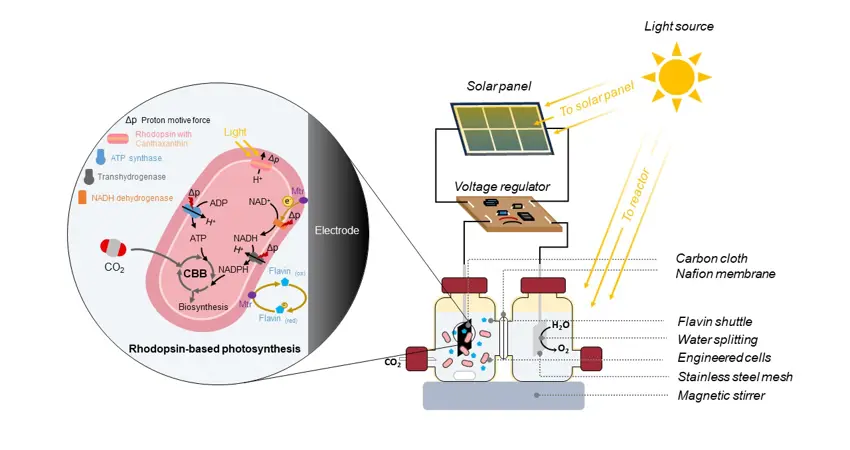21 Dec 2023
Artificial photosynthesis based on simple microbial rhodopsin demonstrates high energy transfer efficiency
An artificial photosynthesis system designed by Oxford engineers by converting a non-photosynthetic bacterium into a photosynthetic one has the potential for industrial application for carbon fixation

Construction of an artificial photosynthesis system by integrating a photo-electrochemical system with genetically engineered cells expressing rhodopsin and an outer-membrane proteins MtrCAB
Solar energy is the ultimate energy source for the earth. Chlorophyll- and rhodopsin-based light harvesting mechanisms are the main systems that transform sunlight into energy. Chlorophyll-based light harvesting is well-known, involving a lot of proteins. Due to the complexity, scientists have not yet constructed a functional chlorophyll-based light capture in a non-photosynthetic organism. In contrast, rhodopsin only has one simple protein, able to express it in many different organisms. It has been discovered that microbial rhodopsins are also major contributors to solar energy capture on Earth, especially in our oceans.
Although rhodopsins are known as light activated proton-pumps, able to power Adenosine triphosphate (ATP) synthesis, their role in microbial carbon fixation has remained elusive. Inspired by the chlorophyll-based photosynthesis system, researchers in the Engineering Science Department led by Professor Wei Huang have constructed an artificial photosynthesis system by converting a non-photosynthetic bacterium Ralstonia eutropha into a photosynthetic one.
This work has been recently published in Nature Communications. Professor Huang says, “This artificial photosynthesis system has the potential for industrial application, because it is cheap, simple and designable, potentially using infrared light, and in principle, we could convert any bacteria into photosynthetic bacteria using the rhodopsin system.”
The technology combines rhodopsin with an extracellular electron uptake mechanism to create a new photosynthetic CO2 fixation with high energy transfer efficiency, up to 6 times higher than chlorophyll-based photosynthesis.
Professor Wei Huang adds, “Up to 40% of marine bacteria contain the rhodopsin proteins. Considering the ocean as a major CO2 sink which absorbs 31% of carbon emissions, we think that the rhodopsins could have played a significant role in carbon fixation in nature.”
Lead author of the study Weiming Tu, a DPhil candidate in Engineering Science, says, “Over decades, environmental microbiologists have been devoted to understanding the role of rhodopsins in microbial carbon fixation. Our previous findings have shown that rhodopsin can enhance carbon uptake and utilisation up to 20%, but driving CO2 fixation requires an electron donor. Therefore, we hypothesised that rhodopsin can be combined with a redox loop to drive CO2 fixation. Synthetic biology allows us to test our hypothesis in model bacteria and make the new artificial photosynthesis.”
Related papers:
Tu, W., Xu, J., Thompson, I. P., & Huang, W. E. (2023). Engineering artificial photosynthesis based on rhodopsin for CO2 fixation. Nature Communications, 14(1), 8012. https://doi.org/10.1038/s41467-023-43524-4
Tu, W., & Huang, W. E. (2023). Rhodopsin driven microbial CO2 fixation using synthetic biology design. Environmental Microbiology, 25(1), 126. https://doi.org/10.1111/1462-2920.16243
Davison, P. A., Tu, W., Xu, J., Della Valle, S., Thompson, I. P., Hunter, C. N., & Huang, W. E. (2022). Engineering a rhodopsin-based photo-electrosynthetic system in bacteria for CO2 fixation. ACS Synthetic Biology, 11(11), 3805-3816. https://doi.org/10.1021/acssynbio.2c00397




